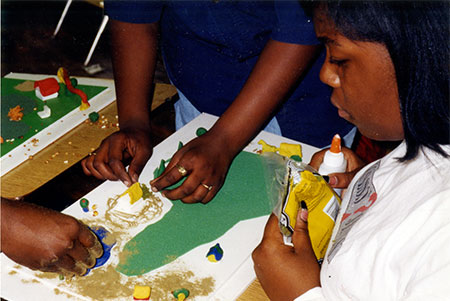
The Mill Creek Mini-Golf project was part of Anne Spirn’s course, Power of Place. During the semester, thirty-two students eighth-graders worked with eleven Penn students to post a guide to their neighborhood’s past on the Internet and to design a business plan for a miniature golf course that tells stories of the neighborhood’s past, present, and future.
The miniature golf course, to be sited on vacant land, was proposed by Empowerment Zone staff to create and sustain new jobs within the community. Ultimately, they decided not to pursue the idea.
From late January to the end of April, Penn students came to the middle school on Tuesday afternoons. They spent the first class introducing themselves to each other.



Penn students led groups of six to seven eighth graders in weekly meetings. From February to early March, each class session focused on a specific time period. There were no lectures; Penn students researched and brought in primary documents each week and asked leading questions to prompt the eighth-graders to puzzle out the significance in the images, texts, and tables before them. At the end of each class, one or more students from each group presented their findings to the class. Between our weekly visits, Glenn Campbell, the SMS teacher, took the material we brought in and used it across the curriculum in social studies, math, science, English and art.






Together, Penn and SMS students chose the stories to tell of Mill Creek’s past and designed a web site that would be a guide to the neighborhood’s history. Each group designed their part of the class web site.



With the help of Penn students, SMS eighth graders created the graphics, designed the layout, and wrote the code for the web site.
Sam Spirn, WPLP webmaster had taught the eight graders HTML, the programming language of the World Wide Web. We decided to teach HTML rather than using web-authoring software because this meant that: 1) the eighth graders understood the principles underlying HTML; 2) they needed no web-authoring software to create websites; 3) they could rapidly learn any web-authoring software in the future.





Penn and Sulzberger students chose eighteen stories from all those they had learned of Mill Creek’s past. They translated these stories into the eighteen holes of Mill Creek Mini Golf. Each student chose a story to write and illustrate. The class then divided into two groups. The first group chose several of the stories to represent in models of golf course holes and collaborated on building models out of cardboard, colored clay, sand, and other materials. The college students learned design at Penn, then taught the eighth graders.



The second group developed a Business Plan for Mill Creek Mini Golf. Penn and SMS students split into three groups. One group prepared the Marketing Plan: they estimated revenue by defining the trading area and market potential and developing strategies for increasing volume over five years. One group developed the personnel plan, including governance structure, staffing needs, setting salaries, and determining benefits. The last group prepared the financial plan with pro forma income statements and balance sheets for the first twelve months and annually for the first five years. The college students learned how to develop a business plan, then taught the eighth graders how to do it.


The Financial Plan team estimated expenses (wages, maintenance, taxes, insurance, debt repayment, depreciation) and net worth (outstanding debt, plant and equipment, retained earnings, receivables and payables). The Penn student in charge of the financial plan plotted these on a spread sheet using MS Excel and taught the eighth graders how to use it. The eighth graders then plugged in the numbers generated by their classmates on the marketing and personnel teams and presented the results. Here they are explaining how Mill Creek Mini Golf will either have to generate more income or reduce expenses.


At the end of the semester, the Penn students presented their own designs to each other and reviewed the Business Plans.



The following is a sample of the work by the students at Sulzberger Middle School.